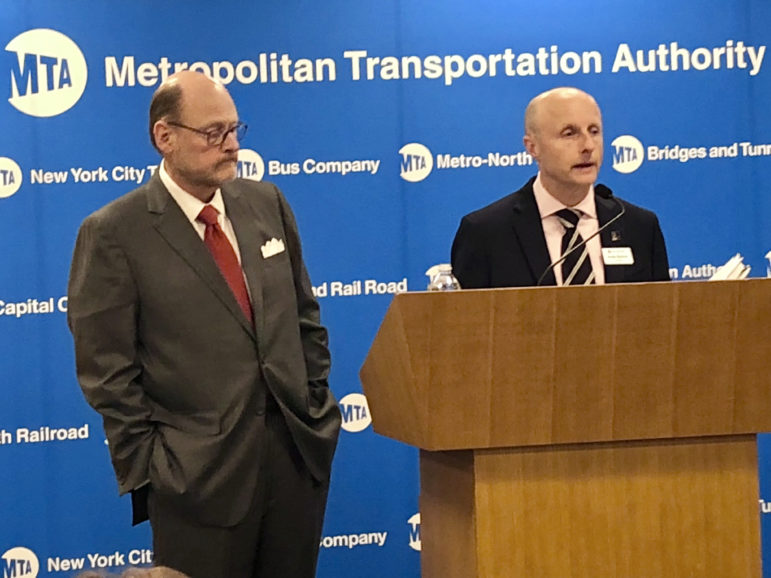
Jeanmarie Evelly / City Limits
MTA Chairman Joe Lhota and NYC Transit President Andy Byford addressed reporters at the MTA’s monthly board meeting on June 20, 2018.
The MTA board formally voted Wednesday to approve a redesign of Staten Island’s express bus network — the first borough to see its bus routes re-evaluated under the agency’s Bus Action Plan, which promises a complete overhaul of the city’s bus system to combat declining ridership numbers.
The new express network will debut on Staten Island on Aug. 19, and will include changes to the names of bus routes, the paths those routes take and to some bus stop locations, the MTA said. The updates are intended to make the system “more coherent and sensible” and to provide faster and more reliable commutes, according to the agency.
For example, the average bus route under the newly redesigned network will make 15 stops before leaving Staten Island, compared to 27 stops on the average route today. While most riders —around 70 percent— won’t see their local bus stop change under the plan, those who do can expect to walk an extra one to five minutes to their new stop locations, the MTA said.
The changes were made after “extensive consultation with the community,” in the form of town halls, open houses and discussions with riders and bus operators, according to New York City Transit President Andy Byford. A list of new route names and other rider information can be found here.
The plan is the first step in the MTA’s vision to modernize its bus network across all five boroughs within the next three years to make routes faster and more efficient, as many haven’t been updated in decades. Bus routes in the Bronx are next up to undergo an overhaul, officials said.
“The first time through is always the longest and most difficult,” MTA Chairman Joe Lhota told reporters Wednesday. “Every subsequent one will go easier and faster based on what we learned.”
For more City Limits’ coverage of the city’s bus system, visit our series here.
Here’s what else came up at the MTA’s June board meeting:
Board member Scott Rechler gave a presentation on ways the MTA can improve how it manages large capital construction projects, something the agency has been criticized for in recent years, as megaprojects like the Second Avenue Subway and 7 line extension finished late and with hefty price tags.
Rechler described the MTA’s capital construction contracts system as being an inefficient one plagued by a “maze” of bureaucracy. His recommendations include appointing a “CEO” in charge of each construction project who would be accountable for its costs and schedule.
Making capital projects more efficient and less costly is essential to addressing the city’s transit crisis, he explained.
“We’re not going to solve this problem without money. We’ve all had this discussion. But we can’t ask the public to give us money if we can’t prove that we’re going to spend that money wisely,” Rechler said. “Not only do we need to re-invest in our infrastructure, but we need to reinvent how we invest in our infrastructure and our system.”
Board members also discussed what they described as a rash of assaults on transit workers in recent weeks, including a Q train conductor who was punched in the head by a rider in Brooklyn on Tuesday. In response, the Transit Workers Union is calling for the MTA to supply its workers with body cameras.
Lhota said they’re looking into that possibility.
“I think it’s a great idea. We don’t know the costs yet,” the chairman told reporters Wednesday. He also suggested putting renewed attention on Transit Watch, an initiative the MTA launched in 2015 to encourage riders to report such assaults if they witness them.
“I think what’s really important is making the public aware that this seems to be increasing,” Lhota said. “To let them be a part of the solution, and making sure that when they see something, they say something.”









2 thoughts on “MTA Board Approves New SI Bus Routes, Talks Construction Contracts and Worker Assaults”
The SI express bus ($6.50 fare) network re-design took over two years. But once Byford was in charge he was willing to listen to riders and elected officials input and changes were made to the original proposal. The HOV lanes on the Verrazano and Gowanus have shortened the commute a bit. The MTA is at least trying. But that new ‘SIM’ route prefix is cumbersome, the old ‘X’ designations worked fine for over 40 years. Once the new network is operational I expect that some routes will be tweaked.
The SI local bus network doesn’t offer much opportunity for major changes or new routes due to SI’s limited arterial road network and lack of a borough-wide street grid.
Final SI express bus network redesign approval (pdf) – –
https://files.acrobat.com/a/preview/917eeb5e-09db-405d-a6bc-6abcfee3bd00
As a rider for 30+ yrs any person in MTA management culd clearly see there is not enough buses on the line, when the bus is full of standing passengers at 5am. From this point if we stand we dont pay…easy peasy…